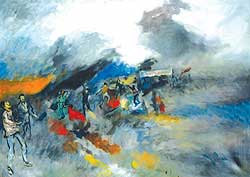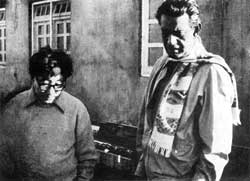 From the son of a Darjeeling tea estate clerk, he eventually became an artist-scholar recognised at home and abroad for his immense contribution to the Nepali art. The life and work of Lain Singh Bangdel is the subject of Against the Current: The Life of Lain Singh Bangdel Writer, Painter and Art Historian of Nepal written by established Nepal-hand Don Messerschmidt with Bangdel's daughter, Dina, currently an art historian at Ohio State University.
From the son of a Darjeeling tea estate clerk, he eventually became an artist-scholar recognised at home and abroad for his immense contribution to the Nepali art. The life and work of Lain Singh Bangdel is the subject of Against the Current: The Life of Lain Singh Bangdel Writer, Painter and Art Historian of Nepal written by established Nepal-hand Don Messerschmidt with Bangdel's daughter, Dina, currently an art historian at Ohio State University. Messerschmidt, an anthropologist who has spent nearly 30 years in Nepal, was intrigued by Bangdel and approached him about writing a biography. "Lain wrote like a painter, he used the pen like a brush. Now I'm painting him in words," says Messerschmidt.
Growing up in a Nepali migrant family in Darjeelingtown, as they called it, Bangdel remembers a feeling of disconnect, of rootlesssness, that was later reflected in his novels and paintings. As a young boy, Bangdel waited for Teej when he could paint colourful motifs on the walls of the festival's maitighar. His upbringing in a Hindu family, and schooling by Protestant and Hindu educators taught Bangdel to respect all religions. But father, Ranglal, didn't allow him to play with the children of common labourers, having worked hard to raise his family's status. It was during his enforced solitude that Bangdel began to sketch-his inspiration found in nature's unparalleled palette.
 In high school during the 1930s, Bangdel was influenced by three Nepali intellectuals: poet Dharnidhar Koirala, Parasmani Pradhan, a Nepali language teacher and Suryabikram Gewali, collectively known as 'SuDhaPa'. Gewali introduced Bangdel to the 19th century poet Bhanubhakta Acharya and Bangdel discovered his other passion-words. He passed the entrance exams to the University of Calcutta. Dad Ranglal who would have preferred his son to be a doctor or teacher, gave Bangdel some money but told him he'd be on his own.
In high school during the 1930s, Bangdel was influenced by three Nepali intellectuals: poet Dharnidhar Koirala, Parasmani Pradhan, a Nepali language teacher and Suryabikram Gewali, collectively known as 'SuDhaPa'. Gewali introduced Bangdel to the 19th century poet Bhanubhakta Acharya and Bangdel discovered his other passion-words. He passed the entrance exams to the University of Calcutta. Dad Ranglal who would have preferred his son to be a doctor or teacher, gave Bangdel some money but told him he'd be on his own. In July 1939, Bangdel headed to Calcutta, his first serious move toward studying art at the Calcutta Arts College. Calcutta was a place where young intellectuals, artists and politicians came together in war-time pre-independence India. In an effort to create an identity for himself, Bangdel changed his surname from Rai to Bangdel, the name of his clan.
But for all this social and political activity around him, Bangdel got through school relying on his art and writings to express his deep humanitarian concerns, remaining apolitical. In 1945, he graduated at the top of his class, and continued to live and work in Calcutta for several more years. Bangdel produced three novels between 1948 and 1951. During his time in Calcutta Bangdel met many influential people and made lasting friendships. Among them: dramatist Balkrishna Sama who rebelled against his Rana ancestry and Satyajit Ray, whose artistic cinematography made strong social statements, became Bangdel's close friends.
 At the age of 31, Bangdel had a chance to go to Paris after General Kaiser Shamsher JB Rana, impressed by Bangdel's portrait of Balkrishna Sama, gave him Rs 5,000. On route he spent four months in London. There he became reacquainted with Manu Kumari Thapa whom he knew from Darjeeling and Calcutta. He toured museums and galleries, losing himself in the works of Leonardo de Vinci and Rembrandt.
At the age of 31, Bangdel had a chance to go to Paris after General Kaiser Shamsher JB Rana, impressed by Bangdel's portrait of Balkrishna Sama, gave him Rs 5,000. On route he spent four months in London. There he became reacquainted with Manu Kumari Thapa whom he knew from Darjeeling and Calcutta. He toured museums and galleries, losing himself in the works of Leonardo de Vinci and Rembrandt. Paris was overwhelming. Everything was new-the language, art, techniques, styles. Bangdel learned French and began to paint again in a tiny studio apartment. Winters were bitterly cold but he survived, sometimes on a single apple a day. These trials gave birth to some of his best works like the Muna-Madan series, Mother Nepal (1953), Pensive Mood (1955) and Famine in Bengal (1856-59). He was influenced by existential writers like Albert Camus and Jean-Paul Sartre. Bangdel met Georges Braque and Pablo Picasso and began leaning towards an abstract style influenced by nature.
Bangdel and Manu Kumari corresponded and in 1953 he proposed to her. She wrote back confused, concerned what her parents would say. She was the eldest child of Chatra Singh Thapa, a descendent of General Amar Singh Thapa. They were married in Paris during spring.
 In 1957, BP Koirala came to Europe and met Bangdel. He came again in 1960, when the couple were living in London. Koirala tried to persuade Bangdel to return to Nepal but the Bangdels had plans to migrate to Canada. Then in 1961, while on a state visit to London, King Mahendra asked Bangdel when he would return to Nepal. Bangdel felt committed.
In 1957, BP Koirala came to Europe and met Bangdel. He came again in 1960, when the couple were living in London. Koirala tried to persuade Bangdel to return to Nepal but the Bangdels had plans to migrate to Canada. Then in 1961, while on a state visit to London, King Mahendra asked Bangdel when he would return to Nepal. Bangdel felt committed. Unsure of their decision, the two came to Nepal where their only child Dina was born in 1963. For the next three decades Bangdel dedicated much of his time to the Royal Nepal Academy, making the Nepal Association of Fine Arts efficient and co-founded the Nepal Art Council. He also turned himself into an art historian and was fascinated with Kathmandu's unique heritage which had been little studied and was falling prey to antique smugglers. So Bangdel set out to document Nepal's ancient heritage, particularly stone sculptures, producing books like Early Sculptures of Nepal (1982), 2500 years of Nepali Art (1987) and Inventory of Stone Sculptures of the Kathmandu Valley (1995). His most popular and most important book, however, was Stolen Images of Nepal (1989), documenting 300 missing religious objects from Kathmandu.
Bangdel died during Dasai of 2002. He wrote and painted to the very end. Against the Current by Don Messerschmidt is due to be released this month. Order forms are at Mandala Book Point for the special limited edition available only in Nepal at Rs 850.


